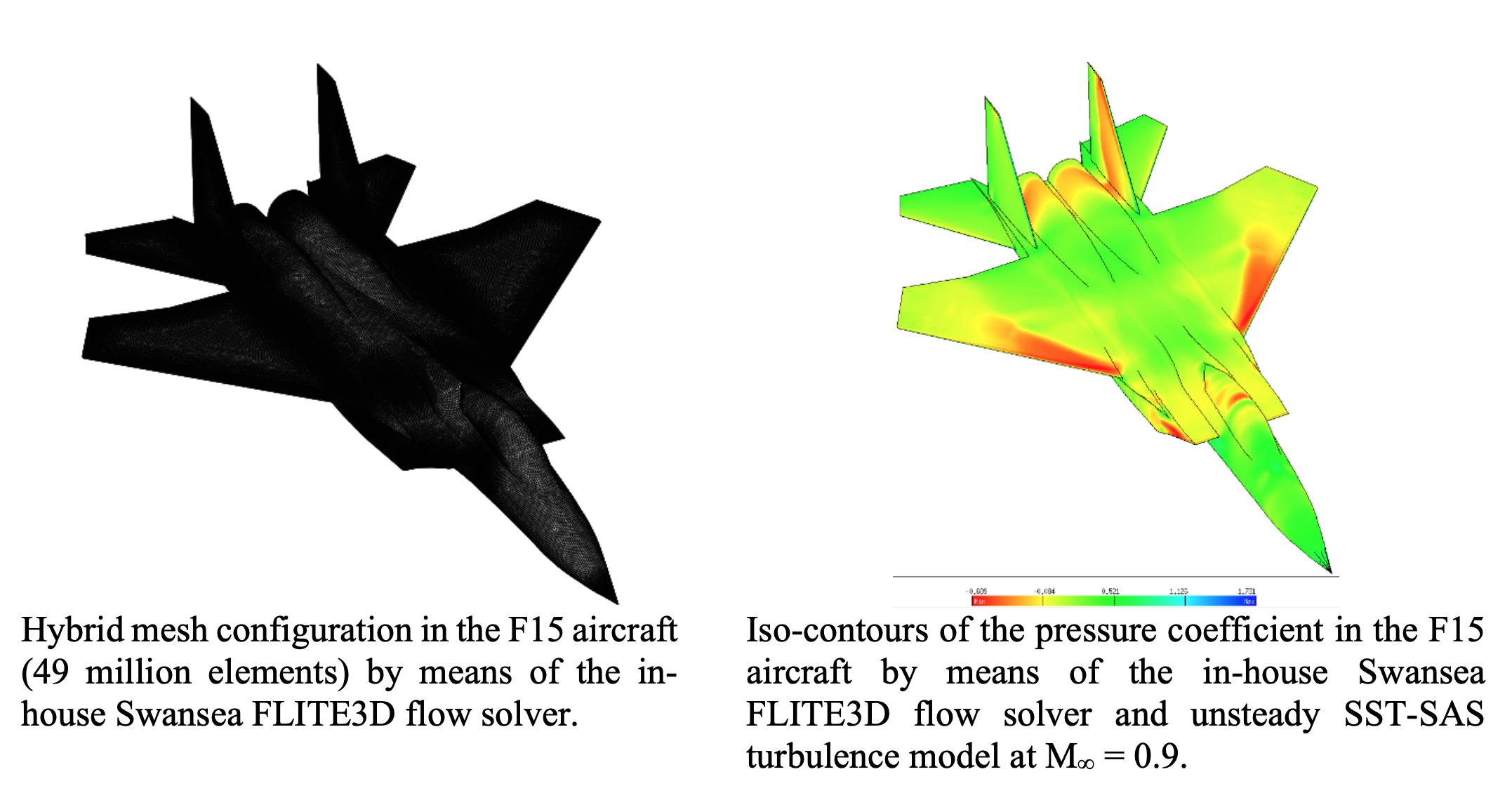Research Projects
Effects of wall curvature on hypersonic turbulent spatially-developing boundary layers (AFOSR#FA9550-17-1-0051)
Guillermo Araya1and Kenneth Jansen2
1Department of Mechanical Engineering, University of Puerto Rico at Mayagez (UPRM), PR 00681
2Department of Aerospace Engineering Sciences, University of Colorado at Boulder (UCB), CO 80309
Introduction
Turbulent boundary layers that evolve along the flow direction are ubiquitous. Computationally speaking, this type of boundary layer poses an enormous challenge, due to the need for accurate and time-dependent inflow turbulence information. Moreover, accounting for the effects of wall-curvature driven pressure gradient and flow compressibility adds significant complexity to the problem. Consequently, hypersonic spatially-developing turbulent boundary layers (SDTBL) over curved walls are of crucial importance in aerospace applications, such as unmanned high-speed vehicles, scramjets and advanced space aircrafts. More importantly, hypersonic capabilities would provide faster responsiveness and longer range coverage to U.S. Air Force systems. Furthermore, an air transportation vehicle travelling at a Mach number of 5.1 might cover the New York-London route in roughly 75 minutes. Thus, the acquired understanding of the physics behind hypersonic boundary layers over curved wall-bounded flows can lead to the development of more efficient control techniques for the fluid flow (e.g., wave drag reduction) and aerodynamic heating on hypersonic vehicle design. In this sense, state-of-the-art numerical simulations performed at the petascale level will be able to supply rich and valuable information.
Intellectual Merit
We seek to develop a robust turbulent inflow generation methodology for hypersonic SDTBL (Mach numbers up to 5) in a suite of high spatial/temporal resolution Direct Numerical Simulation (DNS) as well as Large Eddy Simulation (LES) at higher Reynolds numbers. The prescription of realistic inflow turbulent conditions is used to evaluate the downstream influence of convex (favorable pressure gradient) and concave (adverse pressure gradient) wall curvatures on: (i) low/high order statistics of ow parameters (velocity, density, pressure and temperature), (ii) intermittency, (iii) energy budget, (iv) power spectra of velocity/temperature fluctuations, and (v) the strong Reynolds analogy (SRA) relations. Furthermore, the extensive information supplied by DNS allows us: (i) to assess the impact of wall-curvature driven pressure gradients on the large-scale structures, and (ii) to propose improvements to sub-grid scale (SGS) turbulence models for the LES approach. The proposed open-source finite-element flow solver (PHASTA) has been able to simulate complex geometries and has shown a great scalability for petascale computing in more than 512,000 cores in Mira (Argonne’s 10 Petaflop Supercomputer). To our knowledge, the proposed petascale DNS/LES study on hypersonic boundary layers on complex geometries and high Reynolds numbers is carried out for the first time.
Broader Impact
The proposed petascale DNS contributes to better understanding of supersonic/ hypersonic SDTBL under the influence of concave/convex curvature, which can lead to the determination of appropriate flow control tools and design optimization in hypersonics science. We will do the highest possible and practical Reynolds number for DNS to compare to Wall Resolved LES. Then we will push the Wall Resolved LES up to higher Reynolds numbers, similar to experimental ones from the literature. Since most of the studies on the role of wall curvature-driven pressure gradients in hypersonic boundary layers have focused only on the velocity field, the proposed numerical experiments will be used to enhance the understanding of the thermal field, as well. Therefore, the uniqueness of this work lies in strengthening the fundamental knowledge of the thermal transport on supersonic/hypersonic curved wall-bounded flows.
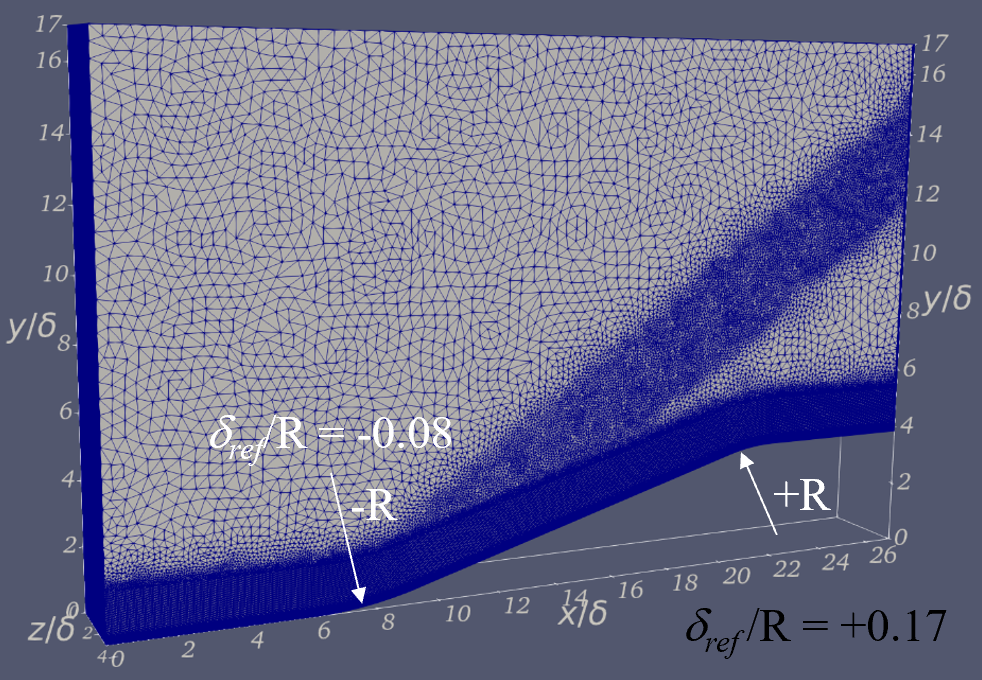
Schematic of the finite-element hybrid mesh (hexahedrals and prisms) for DNS (flow from left to right)
 Iso-surfaces of Q-criterion colored by instantaneous streamwise velocity fluctuations, u‘.
Iso-surfaces of Q-criterion colored by instantaneous streamwise velocity fluctuations, u‘.
 Instantaneous streamwise velocity colored by streamwise velocity fluctuations, u‘.
Instantaneous streamwise velocity colored by streamwise velocity fluctuations, u‘.
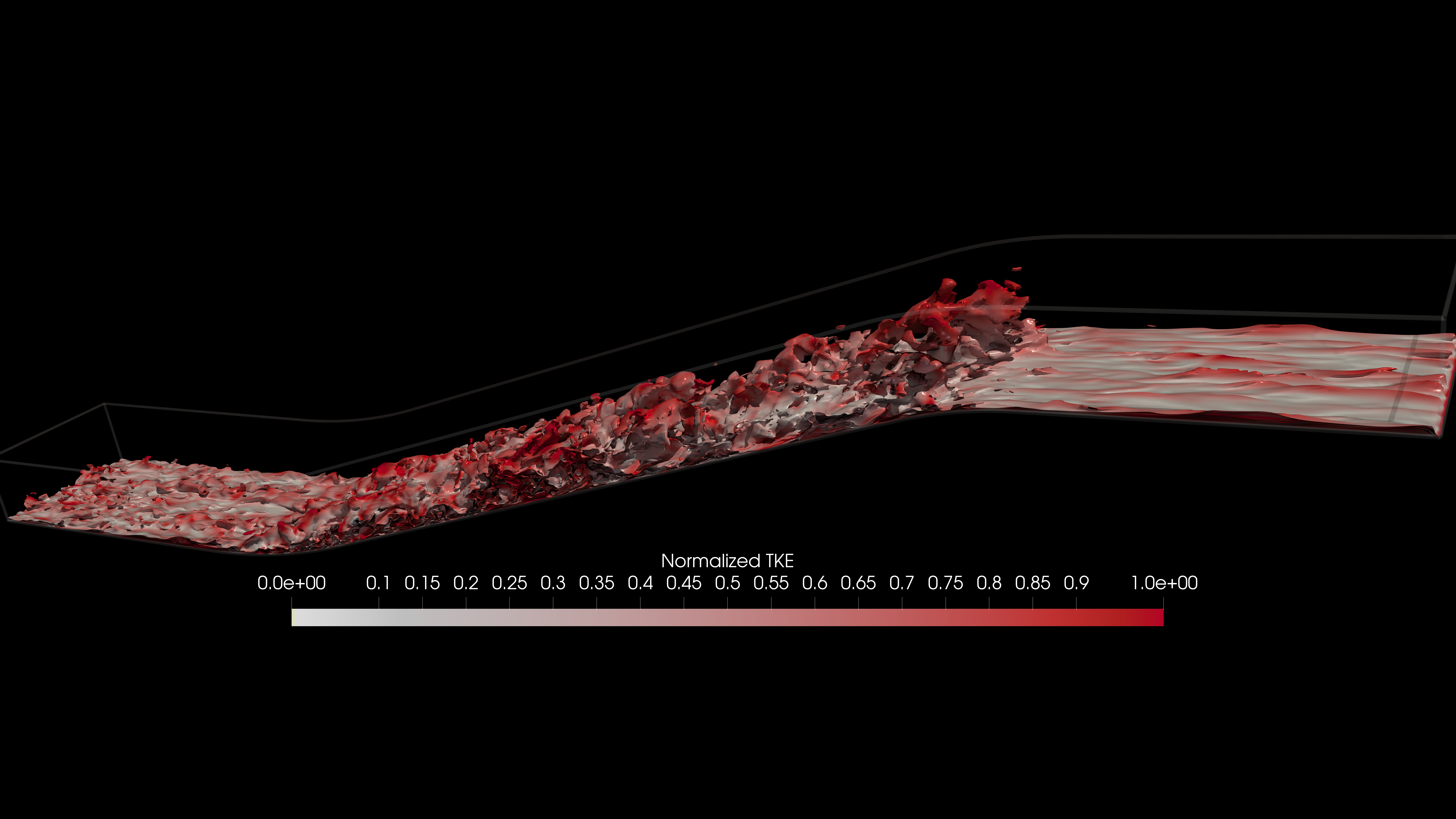 Instantaneous velocity magnitude colored by turbulent kinetic energy.
Instantaneous velocity magnitude colored by turbulent kinetic energy.
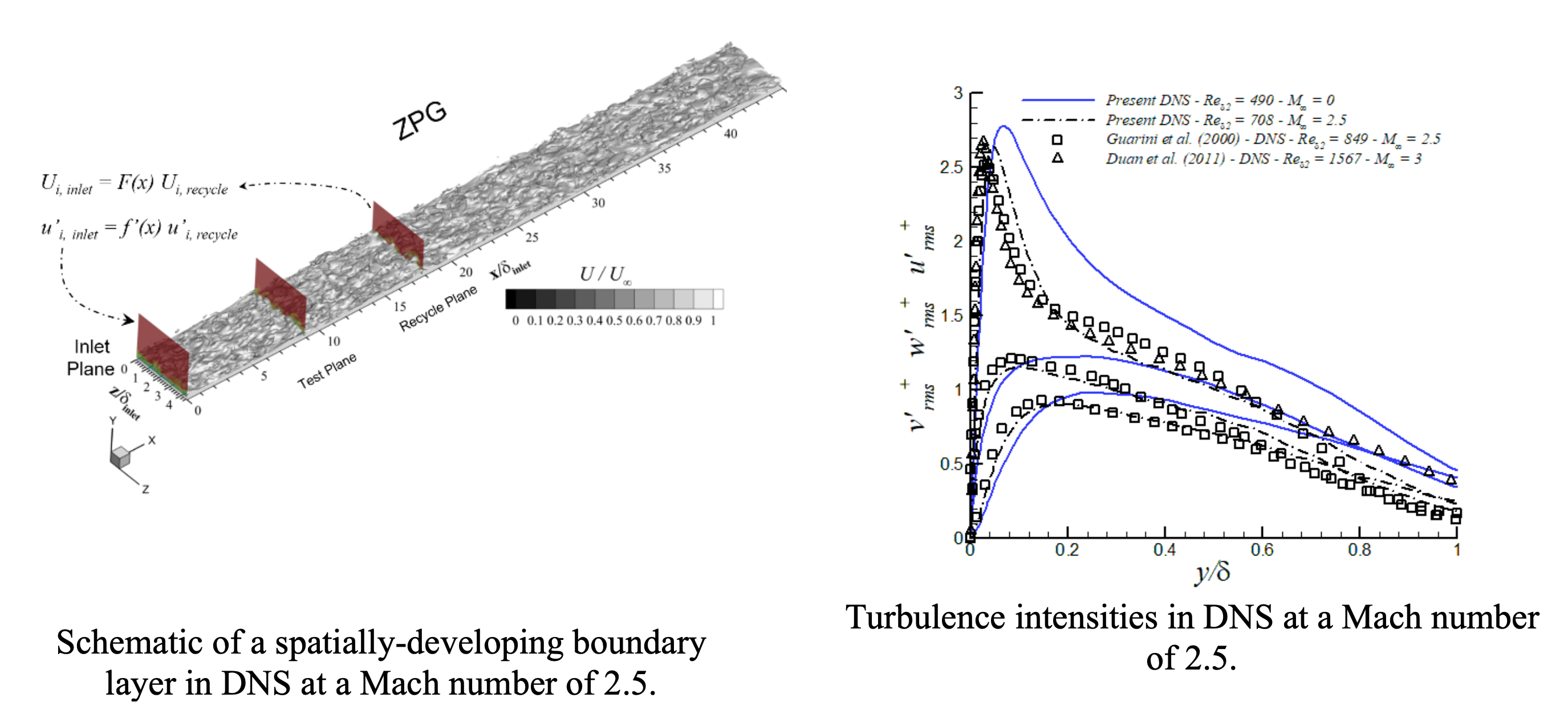
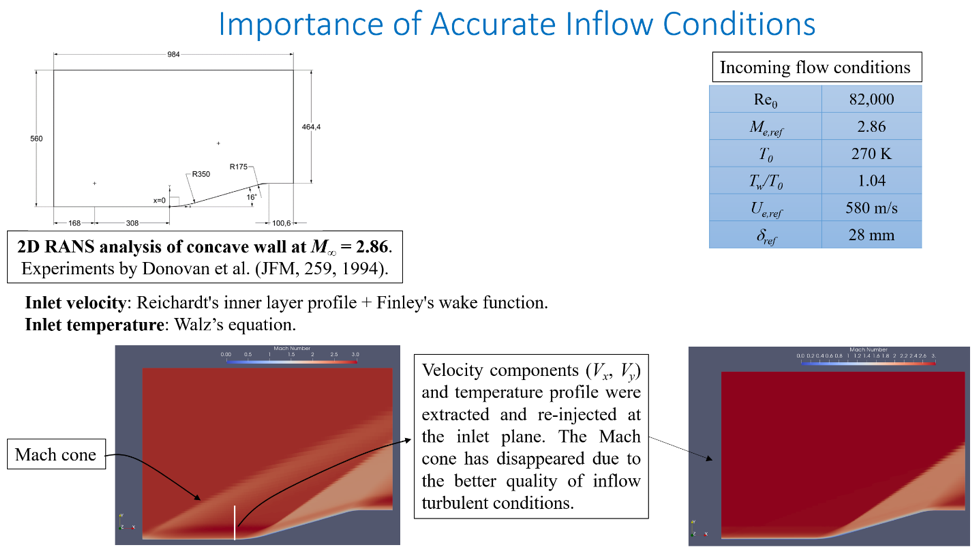
High-end visualization of coherent structures and turbulent events in wall-bounded flows with a passive scalar (NSF-GECAT #074984-16663)
Guillermo Araya1, Guillermo Marin2& Fernando Cucchietti2
1Dept. of Mechanical Eng., University of Puerto Rico at Mayaguez, PR 00681, USA.
2Barcelona Supercomputing Center, Barcelona 08034, Spain.
This project leverages the participants’ expertise in the area of Direct Numerical Simulation (DNS), thermal-fluids, parallel programming, scientific visualization and virtual reality to identify, assess, track and visualize coherent structures and turbulent events in pressure-gradient boundary layers and their implication in passive scalar transport. Time-dependent 3D flow visualization involves dealing with massive amounts of data, which implies huge computational resources, not to mention a previous Navier-Stokes equation solving. The main research objectives are three-fold: (i) to perform DNS of spatially-developing turbulent boundary layers subject to streamwise pressure gradients with passive scalar transport, (ii) to conduct post-processing interface software development in order to make DNS data readable by Autodesk Maya, Blender, Paraview and Unity-3D game engine, and (iii) to carry out scientific visualization of turbulent structures and events by means of flow animations and fully immersive approach or virtual reality (VR). For such endeavor, the role of the Barcelona Supercomputing Center (BSC) will be crucial in terms of availability of cutting-edge technology (for instance, Mare Nostrum supercomputer and Visualization Group) as well as expertise of its personnel.
Intellectual Merit: These research efforts are making use of tremendous computational resources, not only during the running stage, but also in the visualization-animation stage. Therefore, state-of-the-art parallel computing and graphics processing unit (GPU) programming are essential. Furthermore, the high spatial/temporal resolution of DNS will shed important light on the physics behind turbulent events and passive scalar transport in highly accelerated/decelerated boundary layers for potential applications to flow/heat transfer control and turbulence modeling.
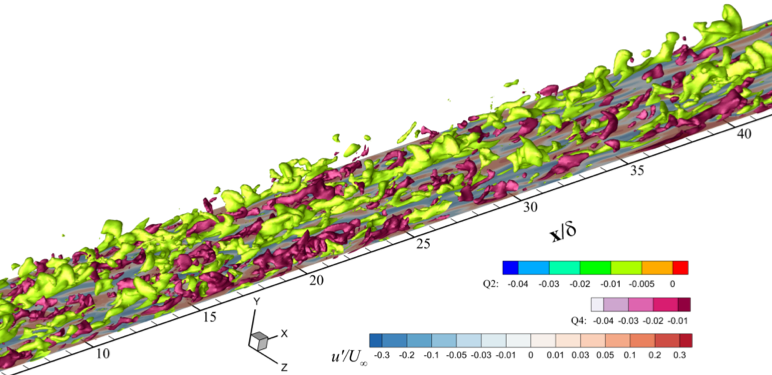
Iso-surfaces of ejections (Q2) and sweeps (Q4) in highly accelerated boundary layers.
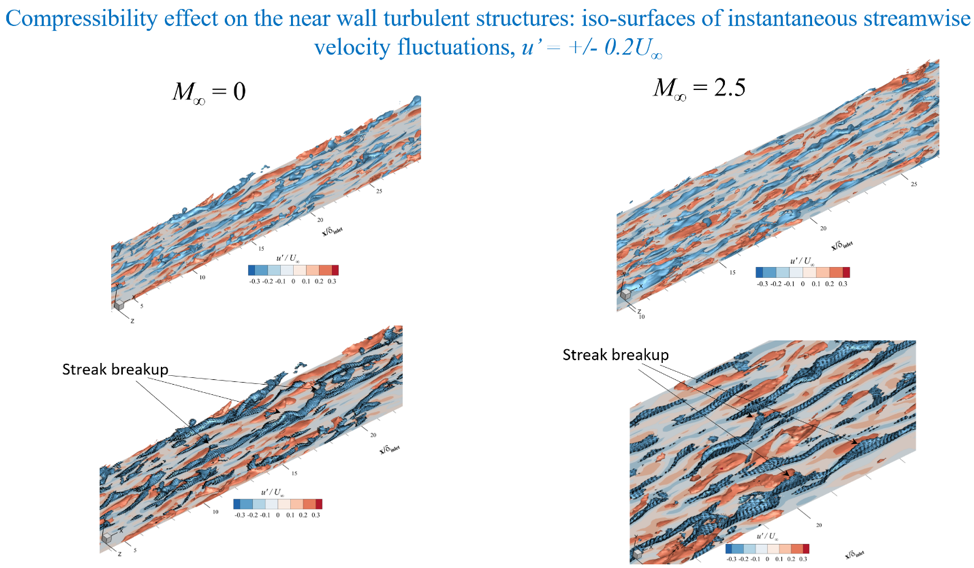
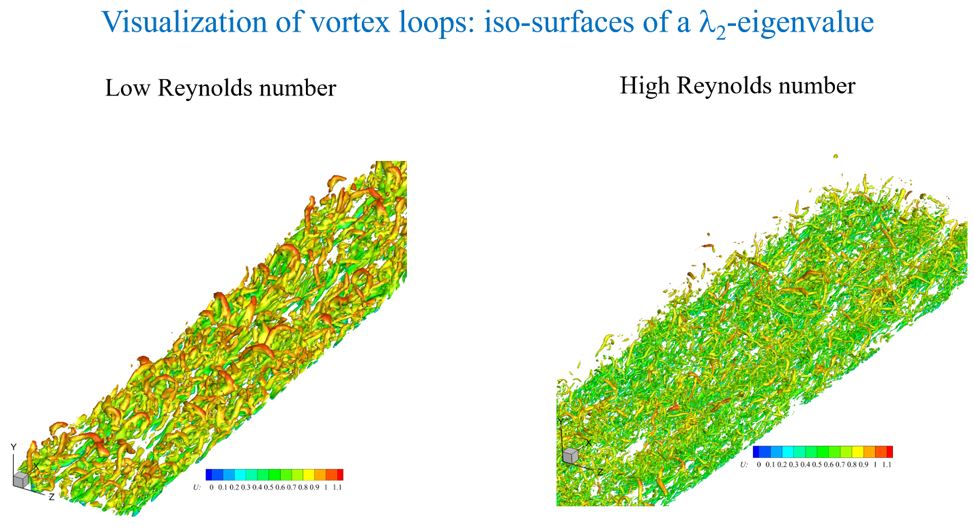
Turbulence modeling and coherent structure assessment in crossflow jets (NASA PR Space Grant Fellowships)
German G. Saltar1, Carlos Quinones1, Walter Silva2& Guillermo Araya1
1Dept. of Mechanical Eng., University of Puerto Rico at Mayaguez, PR 00681, USA.
2NASA Langley Research Center, Hampton, VA 23681, USA.
Incompressible jets transversely issuing into a spatially-developing turbulent boundary layer is one of the most challenging types of three dimensional flows due to its thermal-fluid complexity and technological applications; for instance, film cooling of turbine blades, fuel or dilution air injection in gas turbine engines, thrust vector control, chimney plumes, just to name a few. The ability to control a flow field in such a way to enhance thermal efficiency is of crucial relevance in aerospace and other engineering applications. Direct Numerical Simulation (DNS) with high spatial and temporal resolution of jets in crossflow subject to very strong Favorable Pressure Gradient (FPG) has been successfully performed during 2017-2018, as part of the NASA PR Space Grant project entitled “DNS of crossflow jets subject to very strong favorable pressure gradient” by Mr. C. Quinones (graduate student) and Dr. Araya (advisor). The analysis was done by prescribing accurate turbulent information (instantaneous velocity and temperature) at the inlet of a computational domain for simulations of spatially-developing turbulent boundary layers. The major achievements and dissemination were: one MSc thesis proposal, three oral presentations, one peer-reviewed conference proceedings article, and, two journal papers in progress. The large and extensive DNS dataset generated (of approximately1.5TB in size) will be postprocessed and analyzed for turbulence modeling purposes and for the objective study of turbulent coherent structures, i.e. Lagrangian Coherent Structures (LCS). The main research objectives of the proposed continuation project are two-fold. The first goal involves performing Reynolds-averaged Navier-Stokes (RANS) simulations of spatially-developing turbulent boundary layers subject to the combined effect of a crossflow jet at different velocity ratios (VR = 0.5 and 1) and streamwise favorable pressure gradient with passive scalar transport. The second goal consists on a better understanding of the physics behind momentum/scalar Lagrangian coherent motions emanating from crossflow jets.
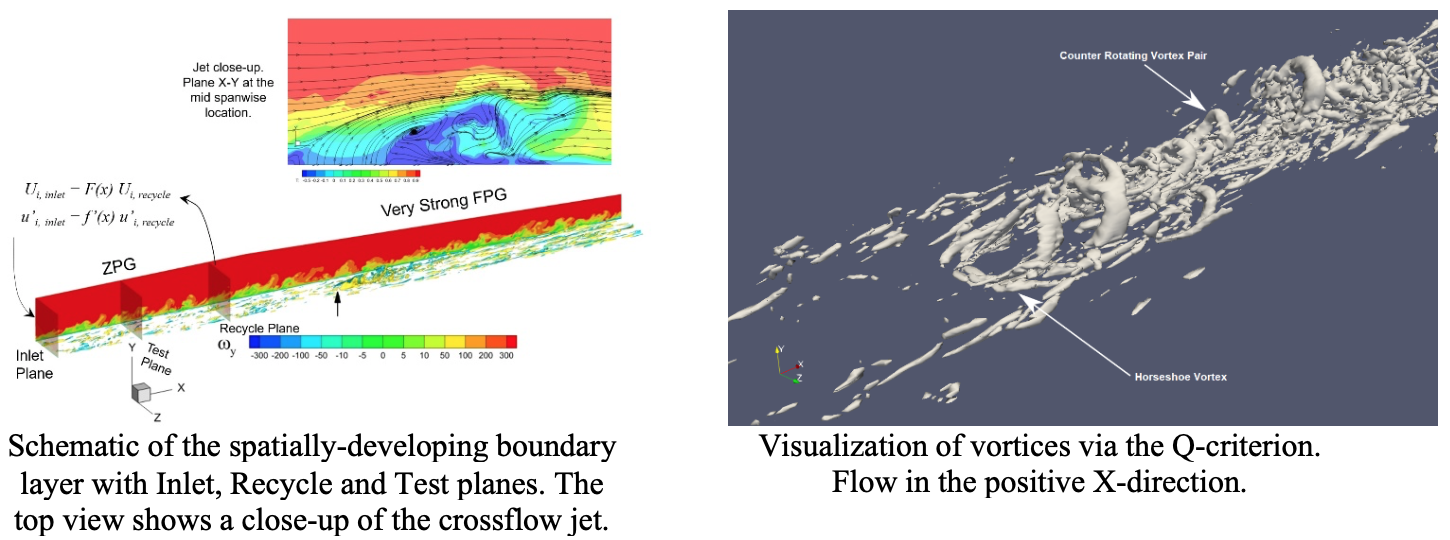
Turbulence modelling for aerospace applications (XSEDE #CTS170006)
Computational Fluid Dynamics (CFD) is significantly gaining ground in the area of aerospace research due to its relative low cost, high accuracy and versatility. Particularly during the design stage of an airplane, it is possible to obtain fast results of different configurations, and, thus minimize the time and the expense of building a wind tunnel model and testing it. Furthermore, with the recent advent of petascale supercomputers with hundreds of thousands of cores, the running time of large scale systems, such as a complete airplane, has been dramatically reduced.
